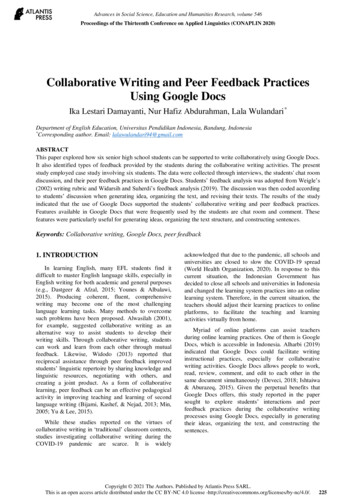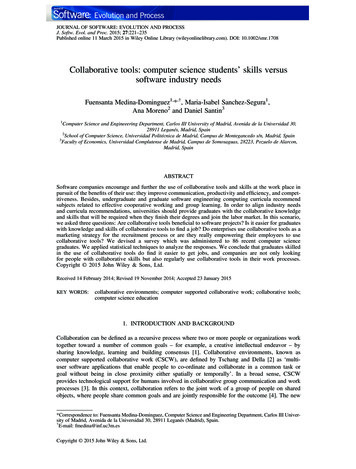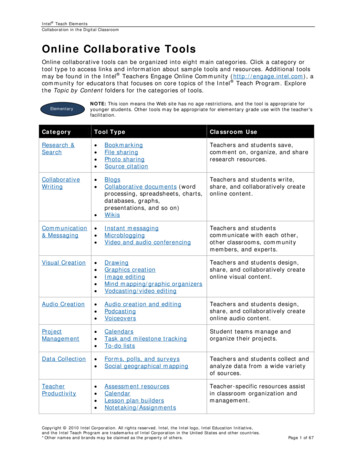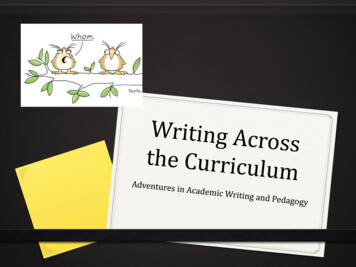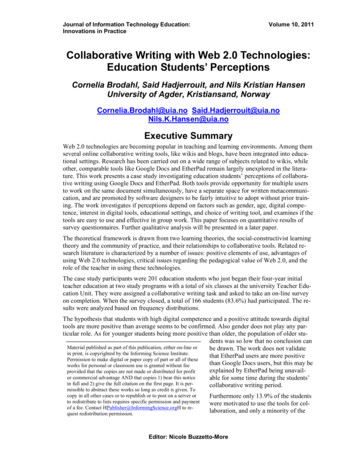
Transcription
Journal of Information Technology Education:Innovations in PracticeVolume 10, 2011Collaborative Writing with Web 2.0 Technologies:Education Students’ PerceptionsCornelia Brodahl, Said Hadjerrouit, and Nils Kristian HansenUniversity of Agder, Kristiansand, NorwayCornelia.Brodahl@uia.no ve SummaryWeb 2.0 technologies are becoming popular in teaching and learning environments. Among themseveral online collaborative writing tools, like wikis and blogs, have been integrated into educational settings. Research has been carried out on a wide range of subjects related to wikis, whileother, comparable tools like Google Docs and EtherPad remain largely unexplored in the literature. This work presents a case study investigating education students’ perceptions of collaborative writing using Google Docs and EtherPad. Both tools provide opportunity for multiple usersto work on the same document simultaneously, have a separate space for written metacommunication, and are promoted by software designers to be fairly intuitive to adopt without prior training. The work investigates if perceptions depend on factors such as gender, age, digital competence, interest in digital tools, educational settings, and choice of writing tool, and examines if thetools are easy to use and effective in group work. This paper focuses on quantitative results ofsurvey questionnaires. Further qualitative analysis will be presented in a later paper.The theoretical framework is drawn from two learning theories, the social-constructivist learningtheory and the community of practice, and their relationships to collaborative tools. Related research literature is characterized by a number of issues: positive elements of use, advantages ofusing Web 2.0 technologies, critical issues regarding the pedagogical value of Web 2.0, and therole of the teacher in using these technologies.The case study participants were 201 education students who just began their four-year initialteacher education at two study programs with a total of six classes at the university Teacher Education Unit. They were assigned a collaborative writing task and asked to take an on-line surveyon completion. When the survey closed, a total of 166 students (83.6%) had participated. The results were analyzed based on frequency distributions.The hypothesis that students with high digital competence and a positive attitude towards digitaltools are more positive than average seems to be confirmed. Also gender does not play any particular role. As for younger students being more positive than older, the population of older students was so low that no conclusion canMaterial published as part of this publication, either on-line orbe drawn. The work does not validatein print, is copyrighted by the Informing Science Institute.that EtherPad users are more positivePermission to make digital or paper copy of part or all of thesethan Google Docs users, but this may beworks for personal or classroom use is granted without feeexplained by EtherPad being unavailprovided that the copies are not made or distributed for profitor commercial advantage AND that copies 1) bear this noticeable for some time during the students’in full and 2) give the full citation on the first page. It is percollaborative writing period.missible to abstract these works so long as credit is given. Tocopy in all other cases or to republish or to post on a server orto redistribute to lists requires specific permission and paymentof a fee. Contact HPublisher@InformingScience.orgH to request redistribution permission.Furthermore only 13.9% of the studentswere motivated to use the tools for collaboration, and only a minority of theEditor: Nicole Buzzetto-More
Collaborative Writing with Web 2.0 Technologies: Education Students’ Perceptionsstudents (15.7%) reported that the quality of collaboration in the group increased with use of thetools. Likewise, the tools did not work as expected for a majority of the students (70.5%). Fortyseven percent of the students liked to comment and edit others contributions to group work.Although the results cannot be generalized to a larger group of students, and no definite conclusions can be drawn from the questionnaires about the usefulness and effectiveness of GoogleDocs and EtherPad for collaborative writing, the results cannot be underestimated since someresults are consistent with the research literature.Future research consists of the qualitative evaluation of the students’ comments to open endedquestions in the questionnaire, the students’ collaborative essay papers, and their contributions togroup work. It may also be important to examine the extent and quality of utilization of the toolsfor collaborative writing. Triangulation of the data collected may shed light on how they reallyperceived the effectiveness of Google Docs and EtherPad to support collaborative writing amongstudents.Keywords: Collaborative writing, collaborative tools, EtherPad, Google Docs, Web 2.0 technologies.IntroductionLow cost, ubiquity, accessibility and ease of use are all potential affordances making Web 2.0technologies more attractive than traditional software in teaching and learning environments (Ajjan & Hartshorne, 2008). During the last few years, the use of several online collaborative writingtools, e.g., blogs and wikis, has been integrated into educational settings. The advantages of wikisfor a variety of different uses and their inclusion in learning processes have been broadly studiedand documented in classrooms, distance and blended learning, as have the potential pitfalls andcritical issues associated with their use. In higher education settings, research has been carried outon a wide range of subjects related to wikis, including issues such as didactic and organizationalarrangements for learning, design of open learning environments, and knowledge production(Baltzersen, 2010; Bonk, Lee, Kim & Lin, 2009; Karasavvidis, 2010; Kasemvilas & Olfman,2009; Pusey & Meiselwits, 2009; Rice, 2009; Su & Beaumont, 2010; Trentin, 2009). Howeverthe use of Google Docs (2008) and EtherPad (2008), being collaborative writing tools relativelycomparable to wikis, remains largely unexplored in the literature (Chu, Kennedy, & Mak, 2009).Although, Garner (2010) provides a discussion of how technologies like Google Docs can supportthe personal knowledge management.Google Docs (GD) and EtherPad (EP) are tools promoted by software designers to be fairly intuitive to adopt for anyone accustomed to a word processor like Microsoft Word or Open OfficeWriter. Yet the fact remains that it is difficult to predict how students will behave in a real educational setting. Taking the complexity of learning processes into consideration, the educational useof GD and EP raises a number of questions. How important is the students’ digital literacy andprevious knowledge in ICT in such situations? What role do parameters such as age, gender, andnumber of collaborators play in the collaboration and learning process? Are GD and EP potentially powerful tools supporting collaborative learning and encouraging the students to collaborate? And, is introducing the tools possible without teaching them in detail? Clearly, there is aneed to explore these issues experimentally.This case study investigates beginner education students’ perceptions of collaborative Web 2.0tools to support academic work. The goal is to enrich the empirical results in this domain by evaluating the perceived effectiveness of GD and EP as online collaborative tools. The investigationis carried out in collaboration with teacher educators in a setting with groups of undergraduateeducation students using the tools to collectively write a reflective essay paper.IIP 74
Brodahl, Hadjerrouit, & HansenThe case study is structured according to three categories: subject, object, and approach. The subjects of the study are education students. The object of the study is the use of collaborative writing tools in teacher education. The approach is exploratory, considering questions posed below,and theory-building.The paper is structured as follows. First, the research question is presented. Second, the theoretical framework is described. Third, the collaborative tools GD and EP are outlined. This is followed by the methodology of the work. Then, the results are presented and analyzed. Finally,some remarks and future work conclude the article.Research Questions and HypothesesThis work examines education students’ perceptions of collaborative writing by means of the collaborative tools GD and EP. The investigation is situated in teacher education and an establishedpartnership between the Faculty of Technology and Sciences and two studies, associated withthree classes each and in two different cities.Accordingly, the research questions are: How do students perceive collaborative writing with GD and EP? Do perceptions vary depending on factors like gender, age, digital competence, interest inand opinion on importance of digital tools, educational settings and choice of writingtool? Are the tools easy to use and effective in group work?The research hypotheses are: Students with high digital competence and a positive attitude towards digital tools aremore positive than average. Younger students are more positive than older. Gender does not play any particular role. EP-users are more positive than GD-users as EP is easier to use.Theoretical FrameworkThe proposed theoretical framework serving as a foundation for this work is drawn from twolearning theories – the social-constructivist learning theory and the community of practice – andtheir reciprocal relationship to collaborative tools. The framework identifies two major elementsand how they might relate to each other: firstly, learning theories that help to understand the verynature of collaborative learning in terms of learner engagement, group discussion, collaboration,participation in communities of practice, language and culture, and negotiation of meaning; secondly, collaborative tools that serve as means of communication for collaborative learning activities where group members use various techniques to write collaboratively, share their knowledge,post information, and discuss issues of common interest. The framework specifies collaborativelearning processes and collaborative tools in a dialectical relationship. The quality of collaboration depends both on students’ prerequisite knowledge in terms of collaborative skills, on the onehand, and the potential capabilities of the tools in supporting students’ collaborative learning interms of user-friendliness and effectiveness, on the other hand. Collaboration presupposes a trouble-free interaction with the tool in order for the students to work collaboratively.IIP 75
Collaborative Writing with Web 2.0 Technologies: Education Students’ PerceptionsThe purpose of this framework is to guide the implementation and evaluation of collaborativewriting with GD and EP. The framework addresses both technical and pedagogical issues of collaborative writing. It provides support to investigate the research questions, analyze and interpretthe results, and draw some conclusions for collaborative writing. The framework is an attempt tomake meaningful links between the collaborative tools GD and EP and collaborative learning,based on current learning theories. The effectiveness of the framework in practice will depend onthe strength of the links between the learning theories and the collaborative tools being used.Socio-Constructivist Learning TheoryTheories of collaborative learning are based on the socio-constructivist theory that knowledge issocially produced by communities of people and that individuals can gain knowledge if they joinknowledge communities (Vygotsky, 1978). From a social constructivist point of view, learning isconsidered an active process in which people construct their knowledge by relating it to their previous experiences in real situations through interaction with the social environment. Thus, learning occurs as learners improve their knowledge through collaboration and information sharing inauthentic contexts. According to Vygotsky, language and culture play essential roles in humancollaboration and communication. As a result, the socio-constructivist learning theory is essentially a collaborative learning theory. In education, collaborative learning is seen as a process ofpeer interaction that is mediated and structured by the teacher.Vygostky’s theory of Zone of Proximal Development (ZPD) expresses the social aspect of learning. ZPD is the “distance between the actual developmental level as determined by independentproblem-solving and the level of potential development as determined through problem solvingunder adult guidance or in collaboration with more capable peers” (Vygotsky, 1978, p. 86). ZPDdescribes the tasks the learner can do, but only with help from a more knowledgeable person.This means that students can learn, but beyond a certain level, they cannot learn alone unless theyare engaged in a level of activity that they cannot manage alone without the assistance of a moreknowledgeable person. Vygostky’s theory of ZDP is a useful construct to understand the tensionbetween individual learning and collaboration with others. Students’ learning development in anonline collaborative environment should not be assessed by what they can learn independentlywith the tools alone, but rather by what they can learn in collaboration with fellow students (Buzzetto-More, 2010; Koohang, Riley, & Smith, 2009).Community of PracticeCollaborative learning becomes even more important when it takes place in the context of acommunity of practice (Wenger, 1998). A community of practice consists of people engaged incollective learning in a shared domain, where learning becomes a collaborative process of agroup. In such communities, students collaborate as they acquire a common understanding of ashared knowledge domain (Lave & Wenger, 1998). Students’ participation in communities ofpractice is based on negotiation and renegotiation of the meaning of the shared domain. Thismeans that understanding and experience are in constant interaction and mutually constitutive(pp. 51-52). Becoming a member of such a community includes learning how to collaborate inthe community (p. 109). In this perspective, participation in online dialogue by means of collaborative tools can be seen as social practices and contextual negotiation of meaning. Collaborativewriting is one example of a shared knowledge space where students come together as communities of learners to share knowledge as they generate content (Dubé, Bourhis, & Jacob, 2006; Parker & Chao, 2007).IIP 76
Brodahl, Hadjerrouit, & HansenTools for Collaborative WritingCollaborative tools can serve as a knowledge platform for a community of practice where members of the community can share their knowledge with the group, post information, work together, and critically discuss issues (Cattafi & Metzner, 2007). The use of collaborative tools ischaracterized by some of the elements fundamental to a community of practice, including anonline presence, a variety of interactions, communication, participation, relevant content, and relationships to a broader subject field of interest. Collaborative tools can be used to facilitate computer-supported collaborative learning, i.e., the development of collaboration by means of technology to enhance learning. In addition, collaborative tools can enhance peer interaction andgroup work, facilitate sharing and distributing knowledge and information among a community oflearners (Lipponen, 2002). Finally, an essential element of collaborative learning is that learnersshould be encouraged to reflect on their knowledge. Collaborative tools allow this reflection to bedone collaboratively, moving closer to a fully social constructivist mode of learning.Collaborative Writing with Google Docs and EtherPadGoogle Docs and EtherPadOne set of Web 2.0 applications are collaborative writing tools, where several people collaborateon producing a document or a set of documents over the Web. Common applications are blogsand wikis. A blog is sequential, sharing content by posts and comments displayed in reversechronological order, but a wiki allows for multiple users to edit each other’s content (Bell, 2009).To modify a wiki page, however, the user must enter an edit-mode and then save a new version ofthe page (Bell, 2009), so a wiki also has a chronological structure. Thus editing is performed on adocument previously written by another author. This may pose a problem as users may feel reluctant to edit other people’s work and to have their own work edited by others (Blau & Caspi,2009).Alternative collaborative writing applications enable synchronous editing and allow users to collaborate in real time. Examples are GD and EP. GD provides a suite of applications consisting ofword processor – having most of the features found in standard word processors – spreadsheet,presentation tool, database, and survey tool. EP is less full featured, but is noted for being particu-Figure 1: Schematic illustration of an editor with conversation space.Document editing takes place in pane A, non-threaded chat in pane B.Color coded highlights indicate author.IIP 77
Collaborative Writing with Web 2.0 Technologies: Education Students’ Perceptionslarly easy to use (Hoya, 2010). Both applications are free. They differ however in that GD requires users to have an account, while EP is open to anybody. EP automatically provides eachauthor with a unique highlight color and updates the document being edited continuously, i.e.,every half second (EtherPad, 2008). Both GD and EP provide automatic saving and also allow theauthor to save at any time. Each saving produces a new document revision. Such revision tracking is a strong feature also provided by wikis. All three systems also offer a means for writtenmetacommunication, in the form of separate discussion pages in wikis and chat fields (see Figure1) in GD and EP.The Writing ProcessFor the task-focused approach to collaborative writing, text editors conveying a conversationspace were recommended and used (Figure 1). These types of co-authoring applications allowwork modes and processes including synchronous and asynchronous co-located activity, as wellas synchronous and asynchronous distributed activity. Authors are able to communicate by writing using artifacts, i.e., the editor (see A in Figure 1) and a conversation space (see B in Figure 1),as well as aurally. Understanding may come from direct communication and interaction throughshared artifacts (Figure 2). With reference to the conceptual model of cooperative work (a, b, c, d,h) by Miles, McCarthy, Dix, Harrison, and Monk (1993), we extend this model to include collaborative writing and communication by means of chat integrated in the tools (e, f, g):(a) Direct communication between participants.(b) Participant’s interaction with the document in editor.(c) Indirect communication between participants through the document in editor.(d) Participants’ mutual establishment of various means to refer to the artifact in editor.(e) Participant’s interaction with other participant(s) in chat box.(f) Online communication in chat box or through chat log.(g) Participants’ mutual establishment of various means to refer to the artifact in chat box.(h) Common understanding from interaction through shared artifacts.Figure 2: Extended conceptual model of collaborative writing, based on Miles et al. (1993).IIP 78
Brodahl, Hadjerrouit, & HansenCollaborative writing using GD and EP is based on this model and utilized depending on the users’ needs and learning styles in a real educational situation.Literature ReviewLooking at the research literature, it appears that published material related to Web 2.0 technologies in higher education is characterized by a number of issues: positive elements of use, advantages of using Web 2.0 technologies, critical issues regarding the pedagogical value of Web 2.0,and the role of the teacher in using these technologies.First, the research literature reports on positive elements of use of Web 2.0 technologies as teaching tools. For example, Rienzo and Han (2009) found significant benefits of using GD in a management course with more than 400 students, and they anticipate additional benefits in the future,e.g., raising collaboration to a new level. Likewise, Tsoi (2010) reported that the outcomes of theprocess of integration of Web 2.0-mediated collaborative activities in terms of the richness of thecontents of the blogs and wikis have been encouraging and positive. Furthermore, Rice (2009)claims collaborative writing in Web 2.0 environments not only to be a practical tool, but also afluid, dialogical situation existing among writers, objects, and the informational contexts. Chu etal. (2009) reported on 14 undergraduate students in the Information Management Program, whofound MediaWiki and GD to be an effective (and enjoyable) online collaboration and management tool. Blau and Caspi (2009) analyzed different types of students’ collaboration on peers’written assignments using GD. They found differences in psychological ownership and perceivedquality of the document, but not in their perceived learning, and believe that a collaborativelywritten document might have higher quality than a document written alone.Second, the research literature also highlights the advantages of using Web 2.0 technologies. Forexample, Kittle and Hicks (2009) discuss, from new perspectives on literacies, issues about howlearners work together and what online tools like word processors and wikis can enable, synchronously and asynchronously. They present sample procedures for how we can teach collaborativewriting using technology and how to pay attention to what is happening in the document andmentally. Similarly, Lamb and Johnson (2010) considered, from the perspective of teacherlibrarians, GD as collective writing tool in inquiry-based education. They discussed ways writingtools can be used in facilitating teaching and learning in order to think, create, and share at thesame time as addressing subject areas in the classroom. Also, Krebs, Schmidt, Henninger, Ludwig, and Müller (2010) think that weblogs and wikis are a promising way to improve students’learning and to impart their 21st century skills, but these assumptions are the best hypotheses.Empirical research is still necessary to confirm the potentialities of Web 2.0 for collaborativelearning.Third, apart from the advantages of using Web 2.0 technologies and the positive results achievedso far reported in the literature, there are still a number of critical issues regarding the educationalvalue of Web 2.0 technologies in comparison to traditional ways of learning. The research literature reports on a number of studies on the use of Web 2.0 for collaboration in educational settings. Elgort, Smith, and Toland (2008) pointed out that many students still favor individuallearning instead of working collaboratively, although wiki technologies require collaborationamong students. According to Luckin et al. (2009), few learners reported engaging in genuinecollaborative learning using Web 2.0 technologies. On the contrary, most learners reported thatthey did not work collaboratively. Furthermore, despite the potential capabilities of Web 2.0,Dron (2007) pointed out that the structure generated through social software intended to supportcollaboration and group interaction may not be pedagogically useful, and there are many waysthat social software can fail to address the learners’ needs. Criticisms are also expressed by Grionand Varisco (2007). They explored the shared construction of professional identity and the natureof interaction in students sharing their case-work, a synthesis of real life scholastic experiencesIIP 79
Collaborative Writing with Web 2.0 Technologies: Education Students’ Perceptionsand pedagogical theoretical reasoning, by means of a collaborative writing tool. They identifiedthe need to provide a space for supporting these novice students to reflect more. Lastly, Brush andSaye (2009) succeeded using collaborative tools (like GD) for school visit inventory and empowering inquiry-based teaching practices in social studies classrooms, having pre-service teacherstudents collectively gather, analyze, and interpret information. However, they indicated that“even if mentor-teachers do have expertise in technology integration and time to mentor preservice teachers, they may not have the opportunity to model diverse teaching strategies in the limited amount of time a preservice teacher is present in their classroom, or they may lack of technology resources at a given placement school” (p. 59).Finally, another important subject for discussion in the literature is the teacher’s role in usingWeb 2.0 technologies. Parker and Chao (2007) think that the role of the teacher is as important asin the traditional classroom. Teachers still need to teach Web 2.0 as a skill, by incorporating social software into classroom, and to prepare students to make innovative uses of collaborativesoftware tools. Likewise, Kim, Hong, Bonk, and Lim (2009) stress that effective teacher intervention is a crucial component leading to better group performance, collaboration, and reflection. Incontrast, Prensky (2010) claims Web 2.0 technology to be a tool that students use for learningessential skills and “getting things done” (p. 103) and that students should be encouraged to useWeb 2.0 tools as much as possible – not necessarily teach them to use technology.MethodologyCase StudyThis case study is about students’ perceptions of collaborative writing tools in a higher educationsetting, where focus is on educational objectives, not on teaching the tools. The case study isbased on a set of research questions and initial hypotheses and uses both quantitative and qualitative data collection methods. This paper is only on the quantitative part of the work. The casestudy also draws on a theoretical framework associated with learning theories and the link to collaborative tools. The case study includes a community of students from two campuses at the sameuniversity.A case study research was chosen for three reasons. First, it provides a suitable context for theresearch questions and the research hypotheses. Second, it helps to find out whether the resultssupport the theoretical framework and existing research work. Third, it uses methods to collectboth quantitative and qualitative data and their triangulation to achieve an adequate understandingof the students’ perceptions of GD and EP.The case study is a part of a larger research and development project (R&D) aiming to enhancestudents’ digital competence and collaborative skills as an activity in a multi-step introduction ofWeb 2.0 technology. Nevertheless, the case may stand alone shedding light on challenges withintroducing collaborative Web 2.0 writing tools.Background for the Case StudyIn comparable countries in Europe, there are differences in national ICT related policies and ICTcompetence targets in initial teacher education (European Schoolnet, 2010). In Norway, there aretargets set for ICT competence for teachers related to use in subjects, but there is no standard ortarget aimed at teachers’ overall ICT competence (Søby, 2009). The policy for ICT integration inteacher training has been introduced at the national level in the new program for initial teachereducation (Norwegian Ministry of Education and Research, 2009), to be incorporated into theinstitutional policies. In preparing its curriculum and syllabus, each teacher training institutionhas to state how digital competences should be built. The challenge then is, within the teacherIIP 80
Brodahl, Hadjerrouit, & Hansentraining institution, to encourage both the teacher educators responsible for teaching a specificschool subject and the educational science subject teachers to operationalize the ICT policy intheir teaching (Tømte, Hovdhaugen & Solum, 2009).Research and Development Project (R & D)At the University of Agder, with the educational science subject teachers’ looking for space andopportunities for students to acquire and practice ICT in the new, expanded subject Pedagogy andPupil-related Skills (PPS), the Faculty of Science and Technology established a project to run forthree years. The main goal of this project, “Learning Arena 2020 – Web 2.0”, is to utilize Web2.0 to create new arenas for collaborative learning. The project investigates learning based onadopting social networking and collaborative technologies. Particular focus is given to the designand organization of learning activities and to the potential methods and ways of learning theymight create. The main target group is students in a variety of teacher education programs withthe clear goal of spreading experiences to the teachers and pupils in schools. The first step of theproject included collaboration with the educational science subject teachers, both at the maincampus (C1) and the satellite campus (C2). While the main campus offers a wide variety of educational studies, the satellite campus has a technology and engineering profile and focuses on mathematics and science as major areas of study in teacher education.Key Elements of the Case StudyThe researchers and collaborating educational science subject teachers designed a mandatorygroup task for the education students in the second month of their education, as a jump-start toutilizing Web 2.0 tools in collaborative learning. The development of the task was based on thefollowing premises and presumptions: Focus should be on the content of the new subject, not on technical skills and tools.Web 2.0 technologies should supposedly be easy to use and take litt
Collaborative Writing with Web 2.0 Technologies: Education Students' Perceptions Author: Cornelia Brodahl, Said Hadjerrouit, and Nils Kristian Hansen Keywords: Collaborative writing, collaborative tools, EtherPad, Google Docs, Web 2.0 technologies Created Date: 4/27/2011 10:05:57 AM
